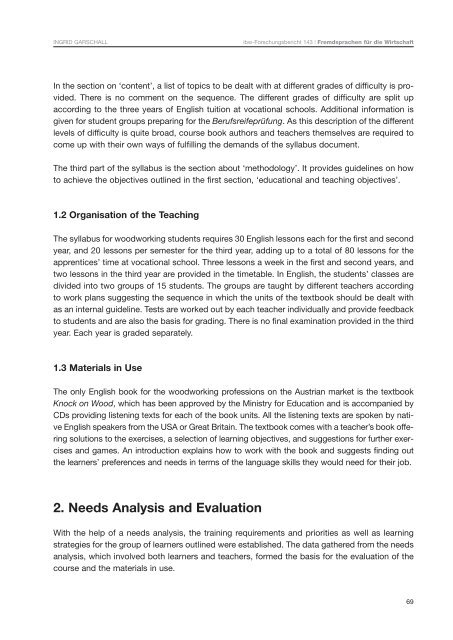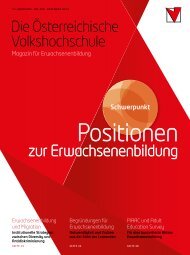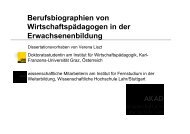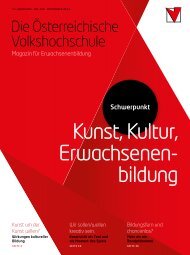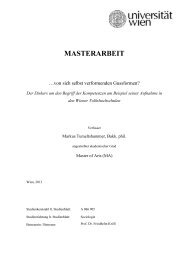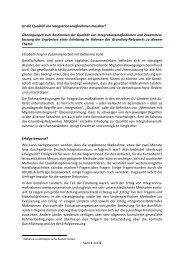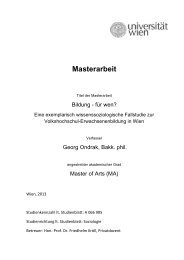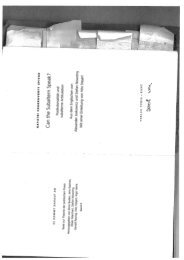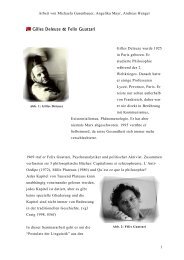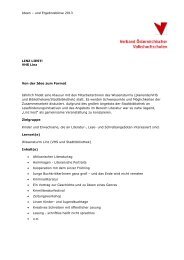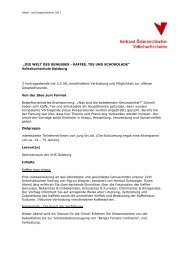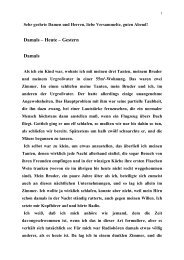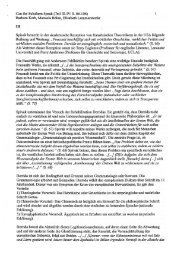Der sichere Umgang mit fremden Sprachen und Kulturen stellt heute ...
Der sichere Umgang mit fremden Sprachen und Kulturen stellt heute ...
Der sichere Umgang mit fremden Sprachen und Kulturen stellt heute ...
Sie wollen auch ein ePaper? Erhöhen Sie die Reichweite Ihrer Titel.
YUMPU macht aus Druck-PDFs automatisch weboptimierte ePaper, die Google liebt.
INGRID GARSCHALL ibw-Forschungsbericht 143 | Fremdsprachen für die Wirtschaft<br />
In the section on ‘content’, a list of topics to be dealt with at different grades of difficulty is provided.<br />
There is no comment on the sequence. The different grades of difficulty are split up<br />
according to the three years of English tuition at vocational schools. Additional information is<br />
given for student groups preparing for the Berufsreifeprüfung. As this description of the different<br />
levels of difficulty is quite broad, course book authors and teachers themselves are required to<br />
come up with their own ways of fulfilling the demands of the syllabus document.<br />
The third part of the syllabus is the section about ‘methodology’. It provides guidelines on how<br />
to achieve the objectives outlined in the first section, ‘educational and teaching objectives’.<br />
1.2 Organisation of the Teaching<br />
The syllabus for woodworking students requires 30 English lessons each for the first and second<br />
year, and 20 lessons per semester for the third year, adding up to a total of 80 lessons for the<br />
apprentices’ time at vocational school. Three lessons a week in the first and second years, and<br />
two lessons in the third year are provided in the timetable. In English, the students’ classes are<br />
divided into two groups of 15 students. The groups are taught by different teachers according<br />
to work plans suggesting the sequence in which the units of the textbook should be dealt with<br />
as an internal guideline. Tests are worked out by each teacher individually and provide feedback<br />
to students and are also the basis for grading. There is no final examination provided in the third<br />
year. Each year is graded separately.<br />
1.3 Materials in Use<br />
The only English book for the woodworking professions on the Austrian market is the textbook<br />
Knock on Wood, which has been approved by the Ministry for Education and is accompanied by<br />
CDs providing listening texts for each of the book units. All the listening texts are spoken by native<br />
English speakers from the USA or Great Britain. The textbook comes with a teacher’s book offering<br />
solutions to the exercises, a selection of learning objectives, and suggestions for further exercises<br />
and games. An introduction explains how to work with the book and suggests finding out<br />
the learners’ preferences and needs in terms of the language skills they would need for their job.<br />
2. Needs Analysis and Evaluation<br />
With the help of a needs analysis, the training requirements and priorities as well as learning<br />
strategies for the group of learners outlined were established. The data gathered from the needs<br />
analysis, which involved both learners and teachers, formed the basis for the evaluation of the<br />
course and the materials in use.<br />
69


